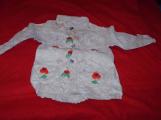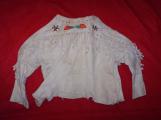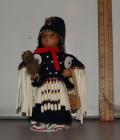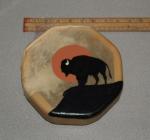2
Children's Toys and GamesHand Game songs were developed and played in traditional times by adults and children alike, by adults as a gambling game. Items of great value such as horses, wagons and rifles were gambled for. The game could be played for amusement, or between clans competitively. Each clan also developed its own songs to play along with the game.
Simple games were created with pieces made from everyday objects such as stones, sticks, or in this case, with small buffalo bones, each 4 cm in length.
Dolls or effigies were a traditional Blackfoot toy, hand made by women, and played with by both boys and girls.
Dolls could be made from simple items, such as willow sticks, with branches for arms and legs. More elaborate dolls were made from cloth or leather materials stuffed with grass, and embroidered with real human hair. Doll clothes were made with full beading from cloth or leather. Often even accessories were made such as tipis and furnishings, horses with travois, or even to scale medicine bundles, used to teach the traditional worships and oral stories.
Traditionally children's dolls were only given facial features such eyes, nose and mouth when they were to be used in ceremonies, or if the doll had some sacred meaning. Facial features - particularly the eyes - were symbolic of being in possession of a soul. Dolls that were meant as children's playthings, such as this one attributed to Mike Mountain Horse, were usually without facial features.
Boys toys were made by men, usually by fathers for sons. This included bows and arrows, leather whips, spinning tops, hand drums, flutes, or horse tack. Boys dolls were often made as warriors or hunters, to teach traditional male roles to boys. Children also made their own fun, using tree branches as stick horses.
The toys were usually kept in rawhide bags for travel.
3
Single Child's Moccasins - "Niitsiitsikiistsi" (original footwear)Circa 1970
Fort Whoop-Up National Historic Site
 Credits:
Credits:Gord Tolton
6
Child's Buckskin Shirt - "Awakaasiistotoc"Circa 1930
Fort Whoop-Up National Historic Site
 Credits:
Credits:Gord Tolton
7
Child's Shirt - "Awakaasiistotoc"Circa 1930s
Fort Whoop-Up National Historic Site
 Credits:
Credits:Gord Tolton
9
Female Doll "Atapiim" (Mike Mountain Horse)Circa 1930
Fort Whoop-Up National Historic Site
 Credits:
Credits:Gord Tolton








